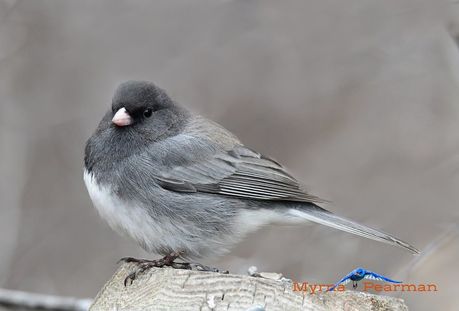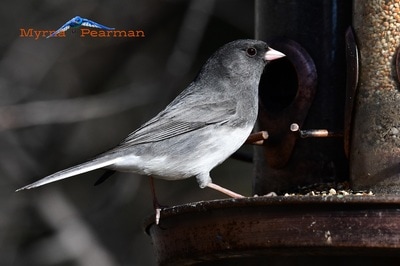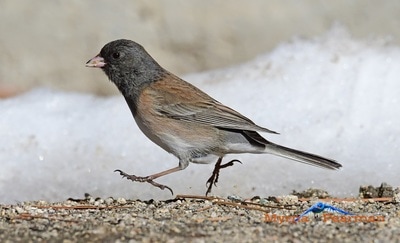 I know that spring has truly arrived when waves of dark-eyed juncos sweep through my yard. Although a few individuals overwinter in Central Alberta each year, it is in late March that these unobtrusive but chatty little sparrows—one of the common birds in North America—start to move through in huge numbers. At this time of year, they are often seen at feeding stations in the company of another early migrating species, the American tree sparrow. Dark-eyed juncos are so named for their dark eyes, but it is their habit of flashing their bright white outer tail feathers that makes them easy to identify, especially in flight. They are also readily identifiable by their distinctive dark hoods and white bellies. Although it is easy to identify these birds as juncos, it is difficult to identify them to subspecies or race because they exhibit so many different plumage variations. Even taxonomists continue to debate species/subspecies/race designations. Two of Alberta’s four races are commonly seen in this area. The most common are the slate-colored juncos, which are slate- or gray colored with white bellies. Less abundant are the Oregon juncos, which can be identified by their distinctively buffy backs and flanks. Juncos are predominantly seed eaters, with insects added to their diet during the spring and summer. They are readily attracted to bird feeding stations, especially during spring and fall migration, where they will dine on sunflower seeds (shelled or unshelled), millet, finely ground corn, canola and nyger seeds. They prefer to feed on the ground, where they hop and scratch amongst the underbrush and fallen seeds looking for morsels. Some individuals will also dine at hopper or tube feeders. Other than when they nest, juncos spend their lives the company of other juncos, moving about in small flocks that feed together during the day and roost together at night. The flocks are controlled by an alpha male, readily identifiable because he flashes his white outer tail feathers or rushes at subordinate birds when he seeks a prime feeding spot. Juncos will soon be leaving the winter flock to nest. Arriving on territory before the females, the males will announce themselves with a loud trilling song (much like a chipping sparrow), often while perched atop a high spruce tree. The males, in addition to spreading their tails and displaying the white outer feathers while trying to impress the female, engage in other interesting courtship behaviours such as hopping up and down, and picking up pieces of nest material or moss. After mating, a pair of juncos will choose a nesting spot, usually on the ground under a stump or overhanging vegetation. The female constructs the nest using her beak to weave materials together and her body to give the nest its shape. Although juncos breed throughout the forested areas of Alberta, their well-hidden nests are hard to find. In all my wanderings, I have found only one junco nest.
Veronica Reist
22/4/2017 03:02:40 pm
I am enjoying your blog. Something to learn all the time .Look forward to the next one .
Reply
Your comment will be posted after it is approved.
Leave a Reply. |
AuthorMyrna Pearman Archives
August 2022
|
All photos and published works on this website are copyright Myrna Pearman unless otherwise noted.
Re-posting these images or publishing is not permitted without Myrna's written consent.
Copyright Myrna Pearman Publishing 2024- Site design and maintenance by Carolyn Sandstrom
Re-posting these images or publishing is not permitted without Myrna's written consent.
Copyright Myrna Pearman Publishing 2024- Site design and maintenance by Carolyn Sandstrom




 RSS Feed
RSS Feed



22/4/2017
2 Comments